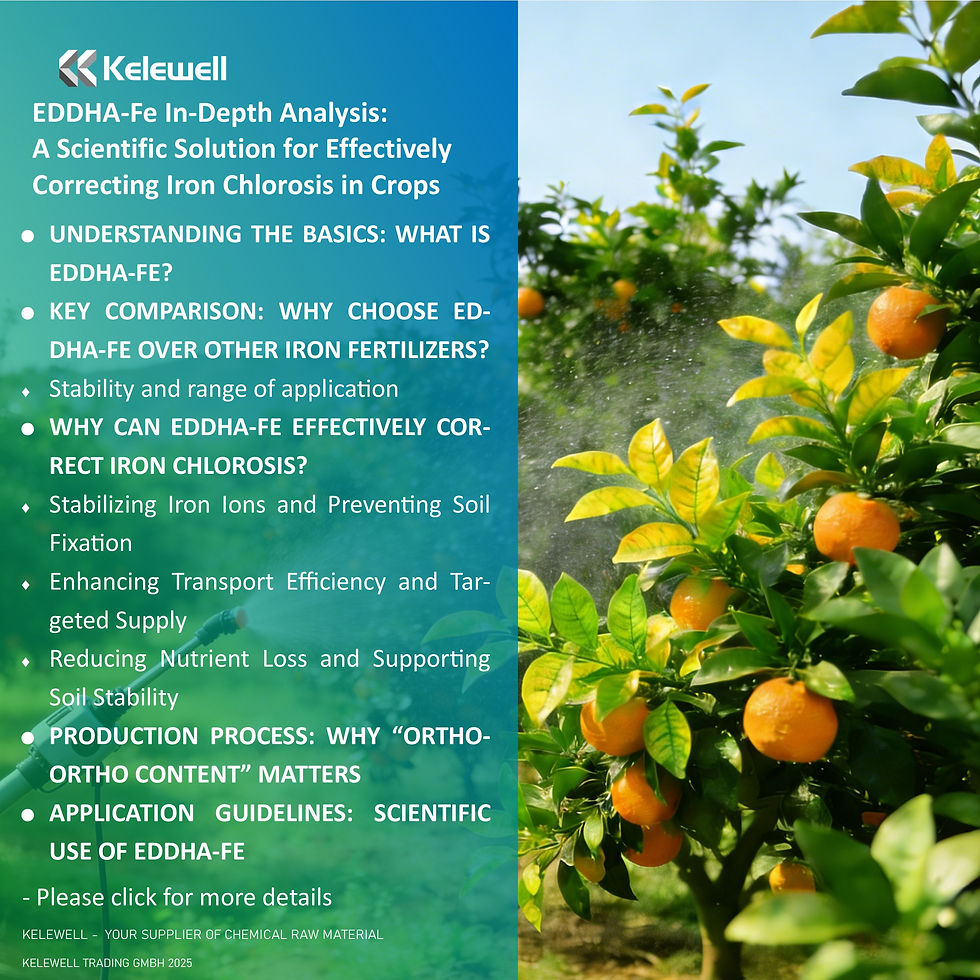The Role of Magnesium in Plant Physiology and the Application of Magnesium Fertilizers — A Key Secondary Nutrient in Building Plant Health
- Antonia Z

- Jun 5
- 3 min read
In modern agricultural practices, the management of nitrogen (N), phosphorus (P), and potassium (K) has matured significantly. However, magnesium (Mg), an essential but often underestimated secondary nutrient, plays an irreplaceable role in maintaining plant health, improving yield, and enhancing quality. With the advancement of precision fertilization concepts, it is increasingly important to revisit the physiological roles of magnesium and apply it scientifically to improve overall agricultural productivity.
I. Core Physiological Functions of Magnesium
Magnesium is extensively involved in fundamental biological processes within plants. Its major functions include:
1. Central Role in Photosynthesis
Magnesium is the central atom in chlorophyll molecules, where four nitrogen atoms coordinate around it to form a porphyrin ring—enabling the absorption of solar energy. Under magnesium deficiency, chlorophyll content in plants can decrease by 30%–50%, significantly reducing photosynthetic rates and causing stunted growth.
Magnesium also regulates the thylakoid membrane potential and activates key enzymes such as RuBisCO, facilitating the transport of photosynthetic products like sucrose to fruits and roots. When magnesium is deficient, these products accumulate in leaves, hindering root development.
2. Structural Support for Protein Synthesis
Magnesium acts as a bridging ion between ribosomal subunits. About 75% of magnesium in plants is involved in protein synthesis, ensuring the accurate translation of genetic information from mRNA into proteins.
3. Enzyme Activation and Energy Metabolism
Magnesium is a cofactor for over 300 enzymes:
It binds with ATP to form Mg-ATP, the universal energy carrier in cells.
It activates key enzymes in glycolysis and the TCA cycle, such as pyruvate dehydrogenase.
It enhances the activity of antioxidant enzymes like SOD, reducing oxidative damage under stress.
4. Other Vital Functions
Lipid synthesis: Works with sulfur to promote the formation of oil bodies in the endoplasmic reticulum, increasing oil content in oilseed crops.
Ion balance: Maintains K⁺/Mg²⁺ ratio, stabilizing membrane potential and nutrient transport.
Seed development: Stored in the form of calcium magnesium phytate, accounting for 70% of the seed's total magnesium, supporting seed germination.
II. Symptoms and Specific Manifestations of Magnesium Deficiency
Because magnesium is mobile in the phloem, deficiency symptoms first appear in older leaves:
Dicotyledonous crops: Interveinal chlorosis → necrosis → leaf curling, leading to reticulated mosaic patterns and early leaf drop (e.g., soybean, cotton, potato).
Gramineous crops: Yellow-green striped mosaic, leaf tip necrosis, and suppressed root development (e.g., wheat, corn, rice).
Economic crops:
Citrus: "Yellow pedicel disease" – interveinal orange-yellowing in middle to lower leaves.
Grapes: Leaf margins turn reddish-brown; visible fruit stalk scars.
Tomatoes: Fruit discoloration, purple-reddish leaves, and poor flesh texture.
III. Soil and Management Factors Leading to Magnesium Deficiency
1. Soil Factors
Low magnesium reserves in red soils and granite-derived parent materials (common in southern China).
High leaching rates in sandy soils.
In acidic soils, H⁺ and Al³⁺ compete with Mg²⁺ for exchange sites, reducing magnesium availability.
Excess K⁺ or NH₄⁺ strongly antagonizes Mg²⁺ uptake—each additional 1 mmol/L of K⁺ can reduce magnesium uptake by up to 40%.
2. Management Imbalances and Climatic Influences
Frequent use of high-potassium fruit-expansion fertilizers → high risk of magnesium deficiency.
Over-liming causes Ca/Mg imbalance, suppressing Mg availability.
Low organic matter (<1.5%) weakens the soil's magnesium buffering capacity.
Heavy rainfall, continuous cropping, or root damage (e.g., from nematodes) intensify magnesium loss and uptake barriers.
Recommended diagnostic thresholds:
Parameter | Critical Value |
Leaf magnesium content | <0.15%–0.25% (dry weight basis) |
Exchangeable soil magnesium | <50 mg/kg (for sensitive crops) |
Potassium-magnesium ratio (K/Mg) | >3:1 (requires adjustment) |
Calcium-magnesium ratio (Ca/Mg) | >10:1 (inhibits Mg absorption) |
IV. Types of Magnesium Fertilizers and Application Strategies
1. Water-Soluble Magnesium Fertilizers (Fast-Acting)
Type | Mg Content | Suitable Soil | Application Method |
Magnesium sulfate (MgSO₄) | 9.5%–16% | Neutral/alkaline | Basal 20–30 kg/ha; foliar spray 0.5% |
Magnesium nitrate | 15%–16% | Protected agriculture | Foliar spray 0.3%–0.5%; fast-acting |
Magnesium chloride | 25% | Chloride-tolerant crops | Drip irrigation 5–10 kg/ha |
2. Slightly Soluble Magnesium Fertilizers (Medium-Acting)
Type | Mg Content | Characteristics |
Calcium magnesium phosphate | 8%–12% | Long-lasting effect in acidic soils |
3. Chelated and Bio-Based Magnesium Fertilizers (Stress-Responsive)
Type | Characteristics | Application Method |
Magnesium with polyols | High absorption, low irritation | Foliar spray 1000–1500 times dilution |
Humic acid-magnesium | Enhances salt and stress tolerance | Soil application with drip irrigation |
V. Conclusion and Future Outlook
Magnesium is not just a fundamental nutrient for crops—it is a multifaceted regulator of growth, reproduction, and stress resistance. As agriculture shifts toward both higher yields and sustainability, managing magnesium efficiently is more important than ever.
Looking ahead, it's essential to establish an integrated “soil–crop–fertilization” magnesium management system. Strengthening regional nutrient diagnosis and refining precision fertilization practices will be crucial. Elevating magnesium from an “invisible nutrient” to a “core regulator” will unlock its full potential in modern agriculture.




Comments